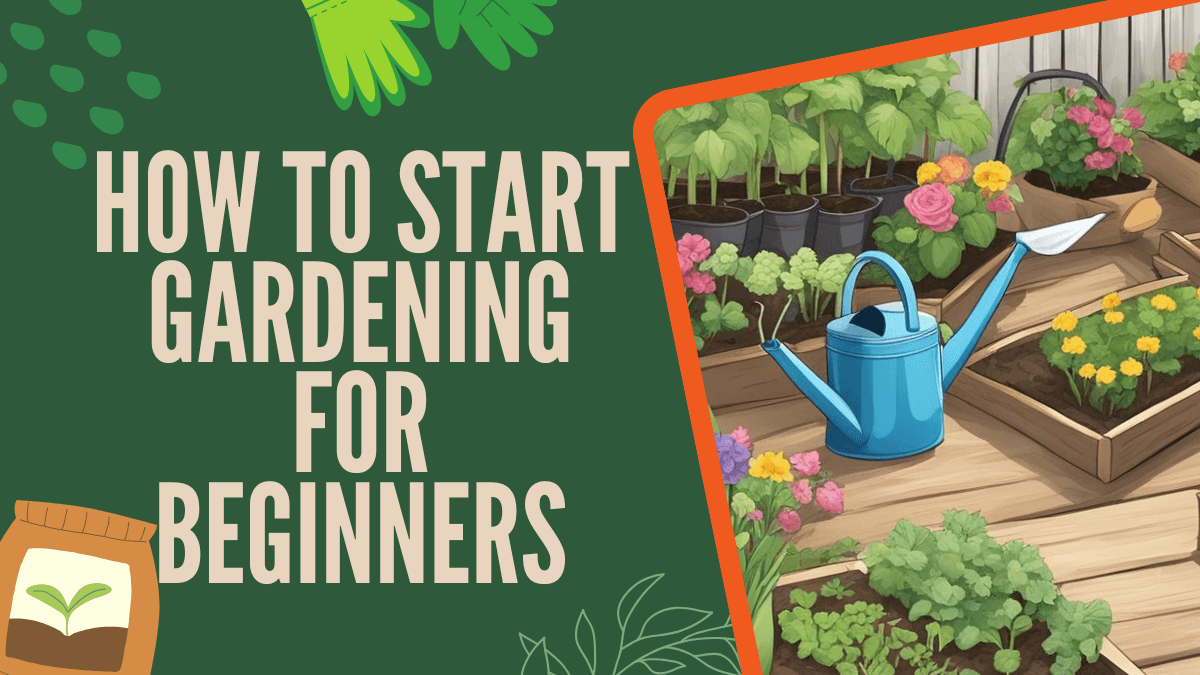Today I’m going to talk about one of my favourite hobbies!
To start gardening as a beginner, choose the right plants for your needs and have the tools and patience. With a little knowledge and prep you can grow your own natural food. It’s peaceful and fun.
When I first started I had no idea where to begin.
It doesn’t take up much space. I started with a few pots on my balcony which made it easier to learn the basics.
Table of Contents
What are the basics of gardening?

Starting a garden involves several key elements. You need to pick the right place, learn about different soil types, and consider how much sunlight your plants will receive. These steps are crucial for success.
Choosing the Right Location
The location of my garden can affect how well my plants grow. I should look for a spot that is easily accessible for watering and maintenance. A flat area is ideal, but a slight incline can help with drainage.
I also need to check for potential obstructions, like buildings or trees. These can block sunlight and reduce airflow. I can make a simple list of these factors to help decide on the best spot.
Soil Types
Knowing soil types is important for successful gardening. The three major categories are sand, silt, and clay. Each has unique characteristics that influence water drainage and nutrient availability.
You can test my soil by digging a small hole and examining the texture. Sandy soil drains quickly, while clay retains water. Loamy soil is a mix of both and is ideal for most plants.
Adding organic matter, like compost, can improve your soil quality and support healthy plant growth.
Sunlight Requirements
Plants have different needs for sunlight. Some grow in full sun, while others prefer shade. You should observe your garden area at different times of the day to see where sunlight falls.
For full sun, your plants need at least 6-8 hours of direct sunlight daily. Partial shade plants need 3-6 hours while shade-loving plants do best with less than 3 hours.
You can make a simple chart to track sunlight patterns, helping me choose the right plants for my garden.
Bonus: Read my full article “Organic Vegetable Gardening for Beginners” to learn more on how to make an organic vegetable garden if you are just starting.
Planning Your Garden Layout

Planning your garden layout is important for a successful gardening experience. You need to consider what to plant and when to plant it. This helps you make the best use of my space and resources.
I have a garden planner, and every season I am planning where, what, and how many plants I will seed.
Choosing What to Plant
To choose what to plant, you first consider your climate and growing conditions. You have to check local plant hardiness zones to see which plants grow in your area.
Next, think about what vegetables, fruits, herbs, or flowers you like to eat. Here’s a simple list that helps you choose:
- Vegetables: Tomatoes, cucumbers, or peppers
- Herbs: Basil, cilantro, or parsley
- Flowers: Marigolds, sunflowers, or zinnias
Some plants, like squash, spread out and require more room. Other shallow-rooted plants like lettuce, spinach, and herbs, can be planted closer together.
Creating a Planting Calendar
Creating a planting calendar is a smart way to keep your garden organized. Start by noting the last frost date for the area.
List each plant along with its ideal planting time. For example:
- Tomatoes: Start indoors 6-8 weeks before the last frost, plant outside after.
- Lettuce: Can be directly seeded in early spring or late summer for fall harvest.
By planning out a planting schedule, you can ensure that you use your garden space effectively. This way can maximize harvesting and keep your garden healthy.
Gardening Tools and Equipment

Choosing the right tools can make gardening easier and more enjoyable. Here are the essential tools I recommend for beginners and tips for keeping them in good shape.
Bonus: You can find some of the gardening tools that I recommend in our “Product Reviews” section.
Important Tools for Beginners
Starting with the right tools can help you grow your garden successfully. Here are the basic tools I suggest:
- Gloves: Protecting the hands from dirt and scratches.
- Hand trowel: Great for digging small holes and transplanting plants.
- Pruning shears: Useful for trimming and shaping plants.
- Watering can: Helps watering your plants gently.
- Garden fork: Assists in loosening soil and turning compost.
- Rake: Helps to clear leaves and smooth out soil.
These tools are affordable and can be found at any garden store. It’s best to choose solid options that will last for many seasons.
Maintaining Your Gardening Tools
Taking care of your gardening tools is important for their lifespan. Here’s how I maintain them:
- Cleaning: After use, I clean tools with water to remove soil and debris. A stiff brush can help.
- Drying: I always dry tools completely to prevent rust.
- Sharpening: Keeping blades sharp ensures better cuts. I use a sharpening stone or tool sharpener.
- Oiling: Applying a light oil helps protect metal parts from rust.
Storing tools properly also matters. I keep them in a dry place, hanging if possible. This keeps them organized and ready for the next gardening session.
Caring for Your Garden

You need to pay attention to how you water, manage weeds and pests, and know when to prune or harvest. Here’s what I’ve found helpful in caring for my garden.
Watering
I water my plants early in the morning or late in the afternoon. This helps reduce evaporation.
You can use a soaker hose or drip irrigation (highly recommend this) for even watering. When watering, I make sure to saturate the soil to about 6 inches deep. This encourages roots to grow deep.
I check the soil moisture by sticking my finger about an inch into the soil. If it feels dry, then it’s time to water. It’s important not to overwater, as this can lead to root rot.
Weeding and Pest Control
Weeds compete with your plants for nutrients and water. To keep them under control, go out to your garden regularly and pull weeds by hand. I find it easier to remove them after rain when the soil is soft.
For pests, inspect your plants often for any signs of damage. Use organic options like insecticidal soap or neem oil. Encouraging beneficial insects, like ladybugs, can also help.
Planting herbs like basil or marigolds can naturally deter some pests. Make sure to keep the garden clean, as debris can attract unwanted bugs.
Pruning and Harvesting
Pruning helps shape plants and encourages growth. I prune my plants in the early spring or late fall. When I do this, I remove any dead or diseased branches first.
When harvesting, look for ripe fruits or vegetables. If you pick them at the right time, they taste better. I use clean, sharp tools to cut the produce, which prevents damage to the plant.
Make sure to have a regular harvesting schedule, as this keeps your plants producing. Leaving some fruits to grow longer can attract pests, so it’s important to keep an eye on them.

What you can find in my blog “The Brown Chair”?
Here are the gardening-related topics that I have covered in my blog.
- 8 Best Garlic Varieties for Your Garden (Hardneck vs. Softneck)
- How to Plant Garlic – 7 Steps to Grow Big, Healthy Bulbs
- Crape Myrtle Varieties for Small Yards – 8 Compact & Dwarf Types
- How to Repot a Monstera Without Stressing It – 7 Simple Tips
- Pruning Crape Myrtle Like a Pro – Mistakes to Avoid
- When and Where to Plant a Crape Myrtle in USA – 6 Essential Rules
- Monstera Fertilizing Guide – When, How and What to Use for Best Growth
- Pruning Monstera the Right Way – 5 Simple Steps
- How to Propagate Monstera – Water, Soil and Air-Layering Methods
- 3 Stunning Placement Ideas for Monstera to Transform Your Home
- 5 Common Monstera Care Mistakes and How to Fix Them Quick
- 8 Best Monstera Varieties You Can Grow Indoors
- Monstera Plant Care – 4 Easy Steps You Should Know
- Phlox Care Calendar – 10 Proven Tips for Year-Round Maintenance Guide
- Top 5 Strawberry Companion Plants – Easy Choices for Beginners
- What Is Sandy Loam Soil – 6 Essential Benefits and Uses
- How to Propagate Phlox – 3 Easy Ways
- 10 Best Companion Plants for Phlox
- 5 Common Phlox Problems and How to Fix Them Fast
- 4 Stunning Phlox Varieties for Every Garden – Creeping, Garden, Woodland and Annual Types
Every one of us starts without any experience, but with love, patience, and will, we can do anything!


 ChatGPT
ChatGPT
 Perplexity
Perplexity
 Claude
Claude
Leave a Reply